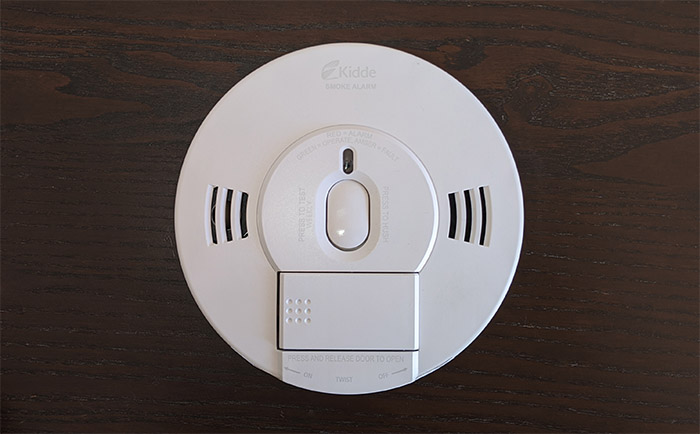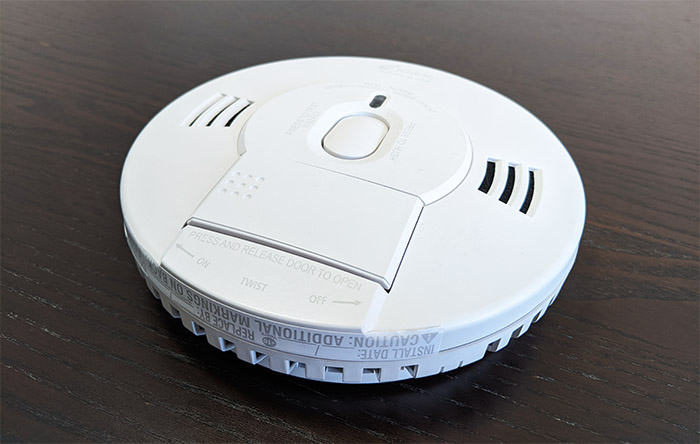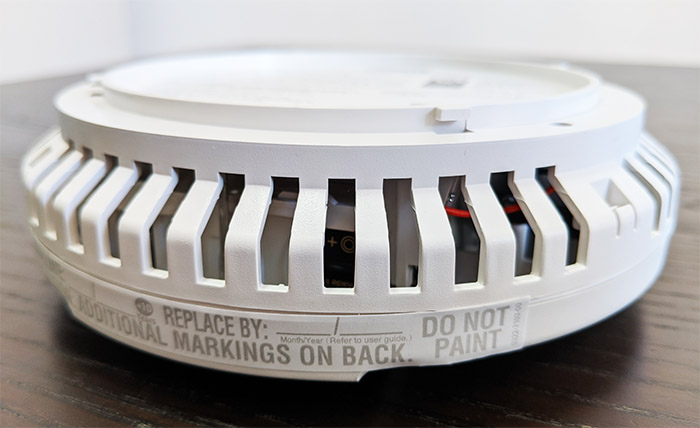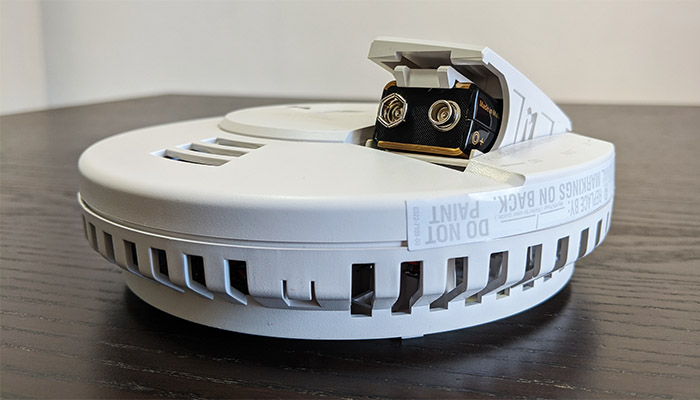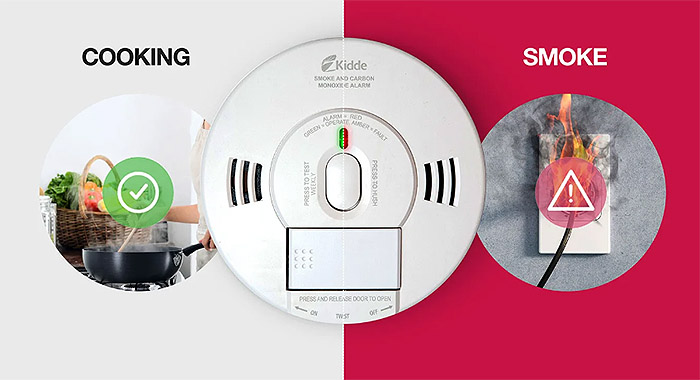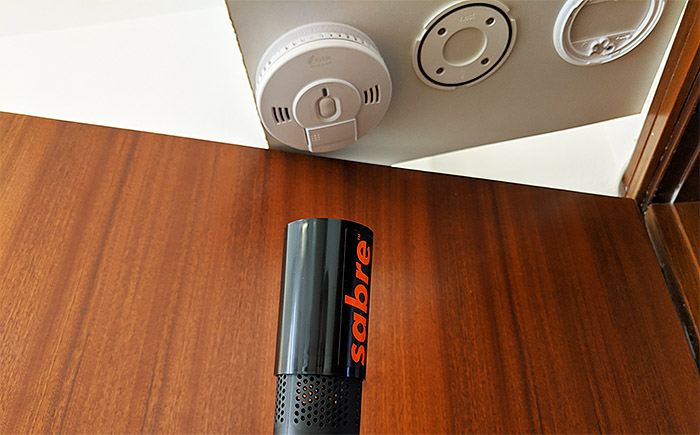Kidde DC Smoke Detector with TruSense Technology Review (2070-VDSR)
Kidde has been for a long time one of the main manufacturers of smoke detectors in the US and, while First Alert fully entered the IoT market and went head to head against Nest Protect with its Onelink smart smoke alarm, Kidde followed a different approach, so it still focused towards the development of the traditional smoke (and CO) alarms but it also provided a dedicated home automation device to listen to all existing devices in case you wanted to get notifications when a problem is detected.
| Kidde DC Smoke Alarm | |
|---|---|
| Amazon.com | Check Offer |
This way, those that consider the smart smoke detectors a riskier solution can still use non-smart, but still state-of-the-art devices and, if you have a bit more faith in the IoT technology, then you can easily add the RemoteLync to the local network which will in turn let you know when it hears any smoke or monoxide alarms (its probably not the most ideal approach, but its a step in the right direction).
Due to the market migrating away from the ionization sensors, Kidde has also recently released a new series of smoke detectors which make use of the TruSense technology that, similarly to the Split-Spectrum sensor from the Nest Protect, it uses special sensors to distinguish between fast flaming and smoldering fires and theres also a lot more focus towards the food-related false alarms, so lets have a closer look at the Kidde 2070-VDSR and see how well it stands next to other solutions from the competition.
Design and Installation
If you ever had another Kidde smoke detector, then the Kidde 2070-VDSR will look very familiar, still sporting that plastic circular case with the characteristic key-like protrusion on top, the entire device being covered by a white matte finish (it does not retain fingerprints). This type of design is quite common and theres little variation even among different brands due to their minimalist nature which makes them very suitable for being mounted on the ceiling or on the wall. Of course, the 2070-VDSR is still far from invisible especially due to its width (it has a diameter of 5.77 inches and 1.86 inches wide; it also weighs 0.6 lb), but I did find it a lot more unobtrusive than the First Alert SCO501CN-3ST (which protrudes a bit more from the wall or ceiling).
The first thing that youre going to notice after taking the device out of the package is the battery drawer along with the 9V battery already inside the tray which you can immediately close if you want to activate the smoke detector (the drawer cant be closed unless theres a battery inside it). Next to the tray, in the center, theres a wiggly large button which has the role of silencing the alarm, as well as to initiate the necessary weekly test. If you push the Silence button, then the alarm will be disabled for about 8-10 minutes and, if during this time, the smoke hasnt cleared to a non-threatening level, then the horn will activate again you should never take out the batteries to silence the alarm since its very easy to forget putting them back and, in case of emergency, you will not be alerted, therefore putting your life (and that of your loved ones) in serious danger.
Next to the Silence / Test button, Kidde has added a relatively small LED (when compared to the large ring of the Nest Protect) which does blink green once every 60 seconds when everything is working properly (no smoke is in the area) and, when the battery is low, then the LED will blink amber once a minute along with the horn which will says Replace alarm (if a week has passed after the alarm detected the low battery, then the notifications cannot be silenced).
In case of an error, the LED will blink amber every 30 seconds (along with the horn notification) and, when reaching EOL (theres a 10-year manufacturers limited warranty), the LED will flash amber twice every 30 seconds, again, followed by the horn; lastly, the LED will flash red (along with long beeps from the horn) when it detects smoke or during a test.
Its worth noting that the speaker is facing upwards (the two sets of cut-outs from the top) and that despite also being made out of two separate parts latched together, the Kidde 2070-VDSR doesnt feel as flimsy as the First Alert SCO501CN-3ST, so its a lot more robust. If you have a look around the case, youll immediately notice lots of cut-out areas and on a closer inspection, theres also a label where you can write the install date and when it should be replaced as anticipated, the cut-out areas allow the smoke to enter the chamber and trigger the sensor.
On the bottom of the device, the mounting bracket is already attached to the smoke detector, so, if you want to read the printed info or lock the device, then you will have to unlock and remove the bracket: it requires a firm counter-clockwise movement.
After removing the bracket, you are now ready to install the Kidde smoke alarm in your home.
The first step is to choose the proper location inside the room which, ideally, should be about 20 inches from the nearest wall (just avoid the corners) and, while you can definitely install it on the wall, youre going to get the best results if you mount the device on the ceiling (although not directly on top of the stove). Once you have decided on the location, take the mounting bracket and mark the spots where youre going to drill a couple of holes, so, using the two screws from the box, attach the bracket to the ceiling (or wall). Next, rotate the smoke detector on the bracket (clockwise movement) and then simply pull the battery tab to activate it in my case, the device came with the battery tray open, so, I simply closed it to activate the detector.
This model operates on batteries, so you dont have to do anything else, but, in case your model is wired, then you will have to make sure to attach the wires to the back of the detector before rotating it into place (if you dont have any experience in how to do this, its best to use the help of a professional). As soon as the device gets enabled, it will chirp once followed by the Push Test Button message to run a quick diagnostics test and see if everything is working fine: it will sound the horn, the voice will say Fire and the LED will flash red.
Note: If you are repainting the ceiling (or wall), you can keep the smoke detector installed by using the dust cover provided in the package.
Features and Performance
The main highlight of the Kidde 2070-VDSR is the TruSense technology which leaves behind the ionization sensor for detecting smoke and using a multi-criteria optical sensor, it can detect both fast flaming and smoldering fires. Most smoke detectors that are installed in the US rely on the ionization method for detecting smoke and the reason for that is because its an older technology, so it was cheaper for the longest time; also, it works quite well especially with fast-flaming fires. This type of smoke detectors have two metal plates (electrodes) which are connected to a power source and, using a very small amount of radioactive material called the Americium-241, it ionizes the air; when the small particles of smoke (from fast-flaming fires) enter the chamber, the sensor detects the change and triggers the alarm.
But, there are two main problems with this type of approach: first, theres the frequent false alarms due to its nature of detecting small particles, so cooking will quickly trigger the alarm and secondly, while the small amount of radioactive material is not going to be a problem for the human beings, it sure will be for the environment and remember that I told you that the majority of Americans have this type of smoke detector in their homes, well, unless properly disposed of, its going to be a major problem.
The second most used type of smoke detectors is more suitable for larger particles and relies on a photoelectric sensor. The technology behind it is quite different, so it relies on a light beam which, by default, it points away from the sensor and, as soon as the smoke particles enter the chamber, the light gets scattered, therefore hitting the sensor and triggering the alarm. I do assume that Kiddes TruSense uses this approach to detect both the smaller and larger smoke particles but I havent yet find anything more than that it uses some algorithms to differentiate between the two to quickly detect when the smoke comes from burned food. Since I also tested the Nest Protect 2nd Generation some time ago, I did see that it also used a combo sensor to detect both types of fires, so perhaps its also a blue light that scatters smaller particles and triggers the sensor.
In any case, hopefully this technology works and the number of false alarms is kept to the minimum. What the Kidde 2070-VDSR smoke detector is missing is an electrochemical CO sensor which would have been very convenient so you wouldnt have to purchase a separate one (and no, you cant skip on it since it also has a vital role in case of an emergency).
Note: Kidde does pride itself as being the first manufacturer to receive certification to the UL 217, 8th Edition standard (will get in effect from May 2020).
Its not easy to test a smoke detector and to truly see how it behaves in various conditions, you would need a laboratory, a lot of expensive equipment and real fire, so I will try to keep it simple and safe. If youre interested to test your smoke alarms by yourself, I have covered a few methods that can be used at home (How to test a smoke detector Four Methods), but to sum it up, the Test button and the smoke aerosol are the most reliable ways, while using real fire is a big no-no.
Unfortunately, the Test button sometimes only checks the circuitry and doesnt properly simulate real fire conditions, so the sensor is left unchecked, but I know for sure that both First Alert and Nest Protect do thoroughly test the sensors and Kidde does say that it also verifies everything by relying on some special algorithms. To be sure that everything is working, the smoke cans are your best friends and thats what Im going to use to test the Kidde 2070-VDSR DC smoke alarm detector.
More specifically, Im going to use the Smoke Sabre Aerosol which has that useful extending plastic piece, so it allows for a better simulation of real-life fire and, as with Nest Protect 2nd gen and the First Alert SCO501CN-3ST, I sprayed the synthetic smoke from various distances and wrote down the time it took for the alarm to trigger.
First, I decided to spray the aerosol smoke for 1 second from about 1 foot away and, after waiting for about a minute, the detector did not react, so I pushed the synthetic smoke for two seconds towards the device which started chirping (more like battleship honking) after about 18 seconds have passed. Afterwards, I decided to increase the distance to two feet and once again tried the two-second spraying which did not trigger the alarm; neither did 3 seconds but at 4 seconds, the alarm finally enabled the horn after about 16 seconds.
Lastly, I put three feet from the smoke detector and the Sabre aerosol and I needed about 5 seconds of smoke (which is a bit excessive) to trigger the alarm after 12 seconds. This is not the best performance, but maybe it has something to do with the TruSense tech which somehow knows that this is synthetic smoke? Or maybe its just less sensitive than other smoke detectors.
Conclusion
I like that Kidde is perfecting its non-smart series, migrating away from the ionization sensor to the better optical sensor and the focus towards eliminating the false alarms is praiseworthy. The Kidde 2070-VDSR is a pretty robust device and the fact that its already UL 217 certified is a good way of getting ahead of the competition, but during the aerosol smoke test, it proved to be the least sensitive when put next to the Nest Protect and First Alert SCO501CN-3ST.
Check the product here:
The post Kidde DC Smoke Detector with TruSense Technology Review (2070-VDSR) appeared first on MBReviews.

